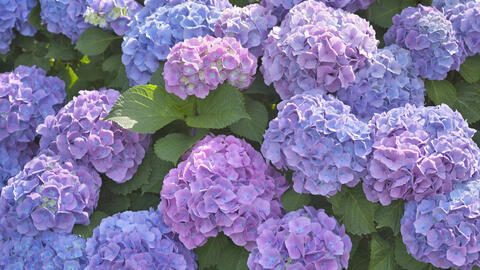5 reasons why your Hydrangeas are not blooming
There may be a number of reasons why your Hydrangea is not flowering in summer, despite being well cared for. Here’s how to get to the bottom of the problem.

Any gardening enthusiast would love a luxuriantly blooming Hydrangea macrophylla like this one here. But sometimes the popular ornamental shrubs simply do not play along
Hydrangea macrophylla and Mountain Hydrangeas sometimes go on strike from flowering, while panicle Hydrangeas and Smooth Hydrangeas bloom reliably every summer after a hard prune in February. Many amateur gardeners are left wondering what they’ve done wrong or if the plant has even been affected by a disease. We explain the five most common causes.
Hydrangea macrophylla and Mountain Hydrangeas flower on new wood, but they create buds with terminal inflorescences the year before. If you carefully open a Hydrangea bud in winter, you’ll already be able to see a tiny inflorescence inside. When you prune the shrubs in spring, remove the majority of flower buds; they are predominantly found on the final third of the shoot. As a result, the plant will not flower for one year. Therefore for these species, in spring, only cut back the old inflorescences to the next healthy pair of buds. Modern varieties like ‘Endless Summer’ and ‘Forever & Ever’ are exceptions: these varieties are able to rebloom – this means that they bloom again the same year, even after a strong pruning.
It’s well known that Hydrangeas are not exactly sun worshippers. However, they should not be too shady either, because this is at the expense of the abundance of flowers. Like most flowering plants which are pollinated by insects, Hydrangeas also exhibit a certain pragmatism: they tend to form flowers in places with better chances of pollination – in other words, a warm, sunny spot, as this is where most insects linger. The best place for Hydrangeas is therefore a flower bed that is only in the shade during warm midday hours.

The nutrients nitrate (nitrogen) and phosphate (phosphorus) have very different effects on plant growth. While nitrogen promotes vegetative growth in particular, i.e. the formation of shoots and leaves, phosphorus is essential for generative growth (flower formation). This is why flower fertilizers also contain a relatively high proportion of phosphate. Most garden soils have sufficient quantities of phosphate, since it is strongly bound to soil particles and hardly washes away. If you only fertilize with nitrogenous fertilizers, such as horn shavings, Hydrangeas can still struggle to flower in the long run. They also become less hardy, because the shoots do not lignify in time for winter. If your Hydrangeas produce strong growth and have a "mast-like" appearance, you should arrange for soil analysis – a combination of too much nitrogen and a lack of phosphate is often the reason.
Hydrangea macrophylla and Mountain Hydrangeas lose a few shoot tips every winter – this is normal and not problematic, as the subshrubs still have sufficient flower buds below the non-woody shoots. Late frosts can cause more damage and sometimes catch hydrangeas off guard in the middle of spring. The young leaves are often damaged, so too are the unopened flowers if they are no longer completely enclosed by the bracts of the buds. Depending on the severity of the late frost, the future blossoms may be partly or even completely destroyed.

To prevent frost damage, it’s important to keep a close eye on the weather forecast in spring and cover your hydrangeas with fleece overnight when there is a risk of late frosts. If the frost damage has already occurred, it’s best to cut all frozen shoots back to the next healthy pair of buds. Depending on the timing of the sudden frost, it’s often only the leaves and buds at the end of shoots that are damaged, as they are the first to sprout. The flower buds located further down still bloom sparsely.
Botrytis or bud rot is a disease that frequently affects potted Hydrangeas during overwintering. The flowers and buds are coated with a gray mold and eventually die. In winter, the shrubs are particularly vulnerable in cold frames, as the humidity is high and temperatures can vary greatly. If possible, after carefully insulating the pots, you should overwinter potted Hydrangeas in a sheltered spot on the patio with fresh air and consistently low temperatures.



